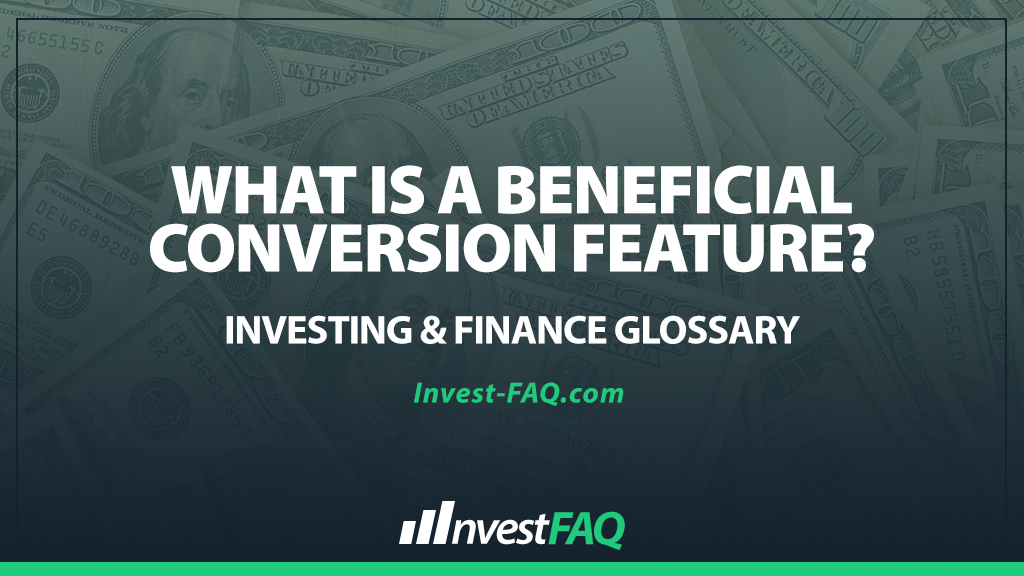
Beneficial Conversion Feature
Contents
A beneficial conversion feature (BCF) is a financial characteristic of certain securities, such as convertible bonds or preferred stock, that allows the holder to convert those securities into common stock at a conversion rate more favorable than the current market value of the common stock.
This feature provides an immediate potential value to the holder, as it offers the opportunity to convert the securities into shares that are worth more than the conversion cost.
In business, companies issue securities with beneficial conversion features as a way to raise capital more attractively.
By offering the potential for conversion into common stock at advantageous terms, businesses can entice investors to provide funding under conditions that are less expensive or dilutive than issuing common stock directly.
This strategy can be particularly appealing for startups and growth companies seeking to minimize cash outflows for interest payments while attracting investment.
Example of a Beneficial Conversion Feature
Imagine “Tech Innovate Inc.,” a technology startup, issues 1,000 shares of convertible preferred stock at $100 per share, with a conversion feature that allows each share to be converted into 5 shares of common stock. At the time of issuance, the market value of the common stock is $25 per share.
Therefore, upon conversion, the holder would receive $125 worth of common stock for each preferred share converted, representing a beneficial conversion feature of $25 ($125 market value – $100 conversion cost).
From an accounting perspective, Tech Innovate Inc. must recognize this BCF as an equity component of the convertible preferred stock.
The value of the BCF, which can be calculated as the difference between the conversion value and the issuance price multiplied by the number of shares (1,000 shares * $25), amounts to $25,000.
This amount is recognized in equity, reducing the carrying amount of the convertible preferred stock and increasing additional paid-in capital.
In this scenario, the beneficial conversion feature offers immediate added value to investors, making the convertible preferred stock a more attractive investment.
For Tech Innovate Inc., recognizing the $25,000 as an equity component acknowledges the intrinsic value provided to investors through the conversion option, without impacting the company’s profit and loss statement directly.
This accounting treatment reflects the economic substance of the transaction and ensures that financial statements accurately represent the company’s financial position and the potential impact of the conversion feature on equity.
Significance for Investing & Finance
The concept of a beneficial conversion feature is significant in accounting for several reasons:
Investor Attraction: It allows companies to raise capital more effectively by offering securities that are more appealing to investors due to the potential for conversion at favorable terms.
Equity Valuation: Proper accounting for BCFs ensures that the value of equity instruments reflects the potential benefits to holders, providing a more accurate depiction of the company’s equity structure.
Compliance and Transparency: Recognizing the value of BCFs in financial statements ensures compliance with accounting standards, such as GAAP, and enhances transparency for investors regarding the terms and implications of convertible securities.
Financial Strategy: Understanding and leveraging BCFs can be a crucial part of a company’s financial strategy, affecting decisions related to capital structure, financing, and growth planning.
In summary, a beneficial conversion feature represents a critical aspect of convertible securities, offering potential value to investors and requiring careful consideration and accurate accounting by issuing companies.
This feature plays a vital role in capital raising strategies, equity valuation, and financial reporting, underscoring its importance in business finance and accounting.
FAQ
How does a beneficial conversion feature (BCF) impact the decision-making process of potential investors?
A BCF makes convertible securities more attractive to potential investors by offering the opportunity to convert into common stock at a rate more favorable than the current market value, potentially leading to immediate unrealized gains and influencing investor decisions towards buying these securities.
What are the accounting implications of a beneficial conversion feature for the issuing company?
The issuing company must recognize the intrinsic value of the BCF as an equity component, reducing the carrying amount of the convertible instrument and increasing additional paid-in capital, which reflects the potential value provided to investors without impacting the income statement.
Can the existence of a beneficial conversion feature affect a company’s stock price?
Yes, the existence of a BCF can affect a company’s stock price as it may lead to an increase in the number of shares outstanding upon conversion, potentially diluting the value of existing shares, though it may also signal company growth and attract more investors.
How is the value of a beneficial conversion feature determined?
The value of a BCF is determined by calculating the difference between the market value of the common stock at the time of the convertible security’s issuance and the conversion price, multiplied by the number of shares that the convertible security can be converted into.
